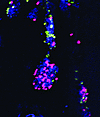Quorum sensing
Series edited by E. Peter Greenberg
Researchers have only recently realized that bacteria use cell-to-cell communication in order to orchestrate gene expression during infection - a phenomenon known as quorum sensing. This series explores the role of these signaling mechanisms and bacterial group behavior in evading host defenses and antibiotics.
Articles in series
Abstract
The existence of species-specific and interspecies bacterial cell-cell communication and group organization was only recently accepted. Researchers are now realizing that the ability of these microbial teams to communicate and form structures, known as biofilms, at key times during the establishment of infection significantly increases their ability to evade both host defenses and antibiotics. This Perspective series discusses the known signaling mechanisms, the roles they play in both chronic Gram-positive and Gram-negative infections, and promising therapeutic avenues of investigation.
Authors
E. Peter Greenberg
Abstract
Until recently, bacteria were considered to live rather asocial, reclusive lives. New research shows that, in fact, bacteria have elaborate chemical signaling systems that enable them to communicate within and between species. One signal, termed AI-2, appears to be universal and facilitates interspecies communication. Many processes, including virulence factor production, biofilm formation, and motility, are controlled by AI-2. Strategies that interfere with communication in bacteria are being explored in the biotechnology industry with the aim of developing novel antimicrobials. AI-2 is a particularly attractive candidate for such studies because of its widespread use in the microbial kingdom.
Authors
Michael J. Federle, Bonnie L. Bassler
Abstract
Traditional treatment of infectious diseases is based on compounds that aim to kill or inhibit bacterial growth. A major concern with this approach is the frequently observed development of resistance to antimicrobial compounds. The discovery of bacterial-communication systems (quorum-sensing systems), which orchestrate important temporal events during the infection process, has afforded a novel opportunity to ameliorate bacterial infection by means other than growth inhibition. Compounds able to override bacterial signaling are present in nature. Herein we discuss the known signaling mechanisms and potential antipathogenic drugs that specifically target quorum-sensing systems in a manner unlikely to pose a selective pressure for the development of resistant mutants.
Authors
Morten Hentzer, Michael Givskov
Abstract
Pseudomonas aeruginosa has two complete quorum-sensing systems. Both of these systems have been shown to be important for Pseudomonas virulence in multiple models of infection. Thus, these systems provide unique targets for novel antimicrobial drugs.
Authors
Roger S. Smith, Barbara H. Iglewski
Abstract
Unequivocal direct observations have established that the bacteria that cause device-related and other chronic infections grow in matrix-enclosed biofilms. The diagnostic and therapeutic strategies that have served us so well in the partial eradication of acute epidemic bacterial diseases have not yielded accurate data or favorable outcomes when applied to these biofilm diseases. We discuss the potential benefits of the application of the new methods and concepts developed by biofilm science and engineering to the clinical management of infectious diseases.
Authors
William Costerton, Richard Veeh, Mark Shirtliff, Mark Pasmore, Christopher Post, Garth Ehrlich
Abstract
Quorum sensing via the accessory gene regulator (agr) system has been assigned a central role in the pathogenesis of staphylococci, particularly Staphylococcus aureus. While the control of virulence gene expression in vitro by agr has been relatively straightforward to describe, regulation of both the quorum response itself and virulence genes in vivo is considerably more complex. The quorum response is highly dependent upon the environment in which the organism is grown and is strongly influenced by additional regulators that respond to signals other than cell density. There is increasing evidence that the agr phenotype may influence the behavior and pathogenesis of biofilm-associated S. aureus and S. epidermidis and may contribute to the chronic nature of some biofilm-associated infections.
Authors
Jeremy M. Yarwood, Patrick M. Schlievert
Abstract
Members of the bacterial genus Streptococcus are responsible for causing a wide variety of infections in humans. Many Streptococci use quorum-sensing systems to regulate several physiological properties, including the ability to incorporate foreign DNA, tolerate acid, form biofilms, and become virulent. These quorum-sensing systems are primarily made of small soluble signal peptides that are detected by neighboring cells via a histidine kinase/response regulator pair.
Authors
Dennis G. Cvitkovitch, Yung-Hua Li, Richard P. Ellen
Abstract
Authors
William Costerton, Richard Veeh, Mark Shirtliff, Mark Pasmore, Christopher Post, Raffaella Adami, Garth Ehrlich



Copyright © 2025 American Society for Clinical Investigation
ISSN: 0021-9738 (print), 1558-8238 (online)







